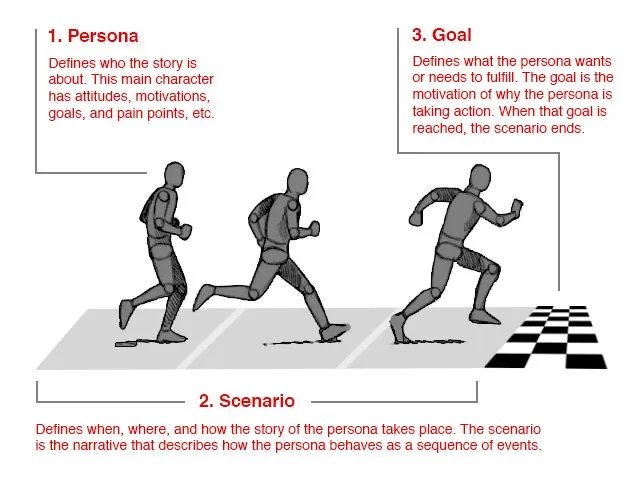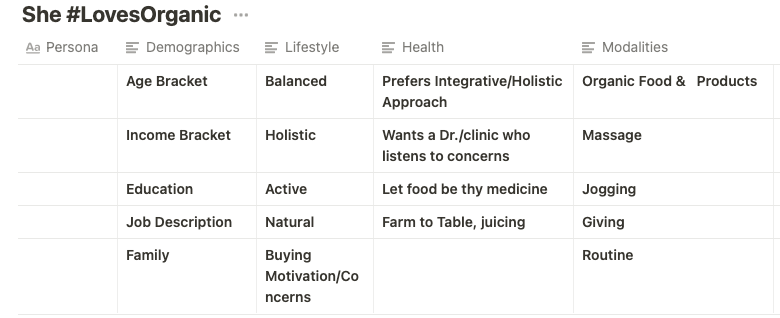Developing User Experience (UX) Personas
Jun 23, 2022
Do you desire to build a robust influence platform? A platform that speaks “expert” and “connects” with your target audience?
If yes, then keep reading.
Today, the most significant influencers are those who build relationships with their customer base. They attach names to their audience while introducing content that solves problems and creates value.
One aspect of marketing that ensures customer or member connection is the integration of “user experience personas.”
User Experience Personas (UX) help you align your products and promotion with the motivations and needs of your target audience.
So, let me ask you a question?
Have you considered the “why” when customers don’t react to your campaigns, download your app, or engage more with your website? Perhaps it’s because the experiences you are creating do not address your audience’s actual concerns or emotions.
The solution? Creating User Experience Personas.
What is a persona?
Personas are fictional characters you create based on your research to represent the different user types that might use your service, product, site, or brand similarly. Creating personas will help you understand your users’ needs, experiences, behaviors, and goals. Creating personas can help you step out of yourself. It can help you recognize that different people have different needs and expectations, and it can also help you identify with the user you’re designing for. Personas make the design task at hand less complex, they guide your ideation processes, and they can help you to achieve the goal of creating a good user experience for your target user group. Interaction-design Foundation.

Personas help you discover, focus on, and showcase your target audience’s motivations, challenges, concerns, and behaviors.
Personas highlight the consumer/patient’s thought process and decision-making so that you can build structures, processes, designs, and content that resonates with them.
Did you know . ...?
In an increasingly choice-driven market, it’s no wonder that “customer-centricity” is a buzzing topic on social media platforms.
What is customer-centricity? Customer centricity puts the subscriber/customer at the center of every product or service design.
To design a customer-centric experience—one that is empathetic and authentic—it’s critical to get a complete, 360-degree understanding of customers as people with real needs, concerns, and feelings for building a solid relationship between you and your client.
There are two types of personas: The Marketing persona & the User Experience (UX) persona.
Marketing personas are also known as the “buyers’ personas.” They reflect a broad demographic audience. They focus on the “who” to target, their likes and dislikes, and one key message that might resonate. They’re helpful when buying retail products, email lists, or building a sizeable demographic campaign.
But, Influence Platforms and Organizations’ fields like healthcare don’t connect with demographics. Instead, they connect with people like you and me.
And this is where the User Experience (UX) personas enter the marketing space.
User Experience personas expose your audience as complex and emotional human beings who don’t always follow a logical path when relating to an influence platform or making healthcare decisions.
They indicate not just one overarching message but the finer points of what motivates them, stops them, their expectations for your brand, and more.
UX personas have real names – John, Simone, Anita – so you build a relationship with them.
Here are a couple of examples:
**Marketing Persona: “women, ages 35-50, married with kids, income over $60K.” **UX Persona: “Anita, 50, Billing Clerk, enjoys swimming and is motivated to stay healthy so she can keep up with her two children. However, she struggles to find time to schedule her dental appointment….or any type of appointment for that matter.”
Although Anita is fictitious and based on demographic data, she feels real now. You understand her concerns and want to build structures, designs, and content that truly meets her needs.
So let’s look at developing a “healthcare” persona. As an influencer, you may have an online exercise/yoga studio, sell natural oils, lifestyle coaching, or healthcare online. This framework also applies to other service industries like Real Estate.
What exactly is a “healthcare” persona?
A healthcare user persona is a qualitative tool that creates a fictional character based on patterns of real people. It serves as a guide for designing and developing a patient-centric experience.
Through personas, we get to know why our customers behave like they do. It’s the” why” **that’s important.
How Do I Choose my “healthcare” Personas?
Start with data. Who are your top audiences? Where are your key growth opportunities? It may be tempting to jump to service lines like primary care, ortho, heart, or cancer, but it’s often better to consider the human first.
Let’s look at a few example persona categories**:**
- Unengaged young millennial,
- a couple starting a family,
- a working mother who cares for herself, her kids, her spouse, and her parents),
- an individual or couple entering into retirement,
- a patient with a chronic condition (perhaps managing diabetes),
- a community member who needs sudden acute care.
Each of these personas approaches healthcare decisions in very different ways. When they come to your website, app, or campaign, they have specific needs for information, the need to connect with what you provide and find solutions for the steps in their journey.
How Many Healthcare Personas (or Influence Platforms) Should you Create?
Generally, three to six healthcare personas work best. Never create more than eight. If you build fewer than three, you’re probably missing key audiences; more than eight is too many to handle, and you’ll stop bonding with each individual and start trying to meet too many needs at once.
How Do I Build a Healthcare Persona?
Personas require both quantitative and qualitative data.
Quantitative data is market research, buyer and usage trends, and web or campaign analytics. This data verifies the types of actions your personas take.
Qualitative data. But it’s the qualitative data, such as stakeholder interviews with staff who regularly interact with patients and the patients who regularly interact with the staff across their journey – this helps you paint the human side of the persona.
Discover and describe your persona’s motivators, healthcare goals, pain points, communication needs, and journey to uncover the healthcare experience from the point of view of your persona.
Three steps you can take immediately to start building your persona profiles:
Step 1: Talk to real people.
The best way to build your healthcare personas is through one-on-one interviews with key consumer segments (patients, researchers, students, providers, and caregivers).
It can take as little as 6 to 12 interviews to see patterns in the data that help you form persona types.
These interviews are best performed, one on one. Often people react differently in groups (focus groups) versus 1:1 engagement.
For example, patient intercepts conducted in a waiting room are a valuable tool because you’re talking to real patients in the actual context of being a patient. Even informal research conducted in a waiting room with actual patients will yield deeper insights than using internal stakeholders as patient proxies.
Building strong personas is less about the demographics and more about what your patients value and how they behave.
For this reason, one persona type can span across demographics.
Often, the researcher begins with a broad, open-ended discussion that eventually focuses on an organization’s products or services.
Below are a few aspects looked at during interviews:
- Values: What does he/she value in a health system (in life when it comes to health) and interactions across the care continuum?
- Goals and Motivations: What outcome does he/she look to achieve as a result of engaging with your organization, and what motivations drive him/her toward fulfilling that goal?
- Challenges and Pain Points: What pitfalls is he/she experiencing when interacting with the health system? How are they feeling during these pain points?
- Behaviors: What day-to-day behaviors impact his/her goals, motivation, and interactions with the organization (e.g., using their phone to manage health needs due to a busy schedule). ****
- Attitudes and Feelings: What do they “feel” when seeking care (scared, frustrated, empowered)? How is that feeling impacted at specific touchpoints?
Step 2: Find commonalities and patterns.
Finding commonalities and patterns is done by analyzing the interviews to derive commonalities.
Each participant is first grouped based on role (physician, patient, researcher, caregiver). Next they are ranked by an attribute scale for each dimension discussed—searching for shared values, attitudes, and behaviors. Finally, as patterns and trends develop, groups of participants with common traits become the foundation for each persona type.
You can categorize participants into personas as broadly or as narrowly as you want. However, you should look for a balance so that your healthcare personas can adequately reflect your customer segments and be most beneficial to reference when making business and marketing decisions.
Step 3: Write the brief persona profile
Based on your findings, you create a fictional profile and story to understand and empathize with your customer and their experience.
This persona generally consists of a fictional persona name (that describes the persona); basic demographics such as age, education, ethnicity, and family status; a quote that summarizes critical feelings; a photograph; a summary of the person and his/her day-to-day life; and critical points as they relate to the dimensions studied in the research.
The goal is to create a real-life snapshot to which employees and key stakeholders can relate.
How can your personas be used?
Healthcare personas have many applications, and when used correctly, they can get your organization a big bang for the buck, so don’t file it away in a market research folder.
Apply it. Personas should be the center of every campaign, product, service, or functional design. When your marketing, promotional, and department teams discuss whether or not an approach will work based on personas, you know you’re building a customer-first culture.
Here are a few tactical applications for organizational teams:
- Designing products or services. Keeping “real people” in mind when creating experiences—waiting-room design, mobile apps, websites, call centers, in-office experience, a stay in the hospital, etc.
- Employee teams should reference key personas to answer the question, “Will this solution work for Persona A? Persona B? Persona C?”
- Crafting personalized or segmented social media/marketing messages. Understanding customer values makes it easier to create messages that resonate with them. Segmenting messages based on crucial persona groups can grow your social media platforms and create loyal followers.
- Building patient journey maps for customer experience improvements. Mapping out a persona’s journey with your brand can help identify and solve critical pain points and improve the overall service experience.
- Prioritizing business and marketing decisions. Prioritizing product roadmaps based on the needs and desires will yield the most positive impact for your key persona groups.
Alterna Healthcare (our fictitious company)
Let’s look at a fictions healthcare company and two fictitious healthcare personas.
Our fictitious company is Alterna Healthcare.
It is a leading integrative healthcare organization that provides training to other healthcare organizations on best practices for adopting integrative healthcare protocols.
Alterna’s primary focus includes best practices for engaging health care consumers and education at the industry level.
They’ve carefully crafted three healthcare personas for individuals who want a holistic approach to medicine.
We’re going to look at one of those now.
Case study #1: Meet the persona “She #LovesOrganic.”
She #LovesOrganic represents women between the ages of 40-55. Her income bracket is 60-80k yearly. Regardless of her career, she loves taking a balanced approach to her work and lifestyle.
She #LovesOrganic is concerned with ingredient safety in everything she buys for her household. She understands the harmful effects of toxins in her body and their impact on her family. As a result, it’s challenging to find products and services that align with her position and passion for food safety.
Like many patients, she has a deep sense of connectedness to her own body, but when she shares her concerns with her current medical physician, she feels ignored. She #LovesOrganic wants her health providers to listen to her. She trusts medicine’s advances but can’t turn away from the health benefits of natural methods and products.
She#LovesOrganic has created her health regimen. She loves routine and has the self-discipline to actively take care of her health. She wears a smartwatch to track her daily exercise and loves to garden, juice, and jog to care for her health. Since undergoing massage treatments, her stress levels have plummeted. Total well-being is a priority in her life.
She #LovesOrganic volunteers her time for causes that align with her passion. She believes that a giving heart goes a long way to help her achieve ultimate well-being.
Let’s summarize the demographic and lifestyle categories we highlighted:

As you can see, an audience persona is crafted to get to the essence of a person.
Organizations that genuinely want to connect to their audience must understand its demographics, lifestyle, connections, and concerns. In other words, “what makes them tick.” Getting to the heart of your target audience helps uncover better ways to speak with, engage and develop relationships with it.
Once developed, your audience personas will help you craft marketing, social media, and promotion campaigns that resonate with people just like the persona. For example, when a She #LovesOrganic “type” stumbles onto your social media channel and sees content she can relate to, the likelihood of engagement is high.
Case study #2: The Honest Healthcare Co (THHC).
Now let’s turn to the other part of Alterna’s business structure: education.
Alterna’s educational services include coaching and training to health care organizations on “how to adopt integrative medicine into their portfolio of services.”
One of their organizational target audience personas is “The Honest Healthcare Co (THHC).”
THHC is a small organization with annual revenue of over $3 million. They value health, integrity, and innovation. They are a leader in advanced medicine, looking for better solutions to meet their patients’ needs.
They often do business with organizations that get to the heart of the matter with streamlined solutions and simple, clean websites.
Because the industry increasingly uses automated processes, they require more technical support and welcome their customer service representatives to help them succeed.
Recently, they have had many patients requesting alternative medicine during their appointments. While they have one physician trained in alternative medicine, they need help fully integrating it into their service portfolio.
When you step into THHC offices, you’ll find a genuinely calm and serene environment where patients feel healthy and whole. THHC has designed its patient experience to convey how much they listen to and care for the needs of those they serve.
While they must look at the bottom line, their predominant motivation is their caregivers’ and employees’ satisfaction when meeting their patients’ needs. Although THHC believes in alternative medicine benefits, they are hesitant to fully integrate it into their practice model because of the unknowns of how it will impact their operations.
As you can see, no matter if your organization markets to other businesses or consumers, it’s essential to hone in on your target audience.
Summary
Personas help you identify the diversity in customer experience and needs (patients, caregivers, researchers, or providers).
Making decisions based on an individual or the last rant you read on your social media page creates inconsistency in messaging and is counter-productive.
Healthcare personas are a valuable tool for condensing and synthesizing both quantitative and qualitative research to understand your customers as real people—and when used effectively, this insight can keep any project focused precisely where it needs to be: on the patients.
In addition to our session and persona development sheets, Impact! is available to help your organization with the development of healthcare personas so you can tailor your social media and marketing messaging?
We have included the links below that aided in developing our “Persona lesson.” These are two exceptional resource articles on building personas:
Linda Watts. Your Guide to Healthcare Personas. February 8th, 2022https://blogs.perficient.com/2022/02/08/your-guide-to-healthcare-personas/
Matt Hummel, CEO. Using Personas to Develop Relevant Marketing Messages. Paragon, Inc. August 3, 2020. https://paragon-inc.com/ideas/using-personas-for-messages/


